Top>Opinion>What the Sanriku disaster area needs now: Challenges made by students as outsiders
 Index
Index
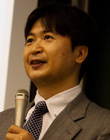
Hideo Nakazawa [profile]
What the Sanriku disaster area needs now:
Challenges made by students as outsiders
Hideo Nakazawa, Et al.
Professor, Faculty of Law, Chuo University
Areas of Specialization: Political Sociology, Regional Sociology
"Filled by Outsiders After the Tsunami" (Sanriku Traditions, Shuichi Kawashima 2012, Living in a Tsunami Town [Tsunami no machi ni ikite], Page 52)
1. Introduction (Hideo Nakazawa, Faculty of Law)
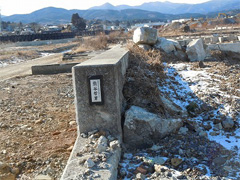
Taken at Kesennuma, former Osaki-Chiku, January 2013
There has been a drastic decrease in the number of news reports related to the Great East Japan Earthquake, suggesting that perhaps there has been a significant loss of interest on the issue. Within the Sendai Plain, the pace of recovery has been particularly fast for Sendai, an ordinance-designated major city, and some have said things like "I wonder how long people are going to keep saying they are disaster volunteers." However, as I think you may recall, everyone was calling for the need for long-term and continuous support immediately following March 11, 2011. In the Sanriku Ria Coast region that we visited, it didn't seem as if there were many openings for temporary housing and in many places the housing foundations remained just as is on the plains that had been washed out by the tsunami (photo). Employment is down and there has been a population drain as a result. For the areas of Kesennuma, Minamisanriku, Rikuzentakata, and Miyako that former Minister for Reconstruction Tatsuo Hirano has indicated as the areas where reconstruction is the most delayed, Chuo University has had the privilege of meeting with these communities and this has moved us to continue to provide attentive support, despite the fact that the media seems to have forgotten these areas. Because they cannot be easily presented as traditional pictures of public service, it can be difficult to explain our close-support activities that consists of supporting the operations of temporary housing communities, thinking of means of providing learning support for children, and looking for first steps to take on the way to regional reconstruction. (The activities are somewhat far different from the common public image of volunteering. However, Chuo University would like to continue volunteer activities from the perspective of being a "regional reconstruction volunteer army.") Concerns arise one after another as phases change. However, despite how busy we are with our daily responsibilities, as university representatives that have acted in a backup role since a changeover was made to student-led activities from April, 2012 (see link below) we all feel a strong sense of satisfaction and emotion towards our roles in developing the young leaders that will propel our society forward in the future. We would like to present to you our impressions of these activities from our advisory standpoint as teachers in the relay essay format that follows. We hope that this paper provides you with at least some understanding of the dynamism in the disaster areas, as we continue to ask what is needed in the disaster area now and what universities and students may be able to do.
Before entering the main theme, I would like to extend my thanks to all of the members of Gakuin-kai, an alumni association that have been supported us. Since we started accepting donations in January 2012, over 4.5 million yen has been donated to the Gakuin-kai's Chuo University Student Volunteer Support Fund. Since April 2012, these funds have been used exclusively for paying for half of the transportation and accommodation costs of student volunteers (the Accounting Department manages the funds and retains vouchers). Up until now, thanks to these funds, more than 400 students have been able to visit the disaster area and build relationships of trust with key persons in the region, such as local disaster victims that are working towards reconstruction. I would like to express my thanks once again, and take this opportunity to remind you that the fund balance is approaching zero. We would gratefully welcome any additional donations. In recognition that the range of Chuo University disaster area support activities over this past year was made possible thanks to the support of the Gakuin-kai, we would also like to present this paper to fulfill our duty of providing a report in response to this benevolence. In particular, I would like to give special thanks to Hirotake Asano of the Chuo University Nanko Club for his generous support in the form of the Kizuna Fund.
2. Minamisanriku tourism program development initiatives (Masayoshi Tanishita, Faculty of Science and Engineering)
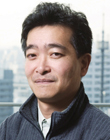
Masayoshi Tanishita
In the Environmental FLP Tanishita Seminar, we study on ecotourism in Minamisanriku-cho, Miyagi Prefecture. The purpose of this study is to encourage a reconfirmation of the true capabilities of the region and independent thinking towards the future of the community. In addition, this study is also aimed at developing and attracting the young people who will lead the future of Japan via development of eco-tourism program.
Ecotourism consists of utilizing various local resources such as nature, everyday life, industry, and local people to provide safe and satisfying tourism programs for visiting customers. The roles of guides and interpreters are important, and accordingly we give attention to bringing out to the fullest the five senses, discoveries, and awareness of customers, as well as encouraging the preservation and passing on of community resources while making contributions to the local community.
In the seminar activities, we received the advice of Hiroyasu Takamine (1978 Faculty of Law alumni, President of Bunanomori Co., Ltd., Director of Japan Ecotourism Society) and the local community and conducted re-evaluation, identification, and proposal of local resources from an outsider's perspective and also established the Yasuraginomori (Serenity Forest) for program development. We learned about many things, such as the links between the entire local ecosystem, the history and culture of living side-by-side with tsunamis, as well as the delicious local cuisine and friendly local people. Refer to the following websites for reports on these activities and related information. A briefing session is scheduled for March 2013 in Minamisanriku.
Activities in Minamisanriku
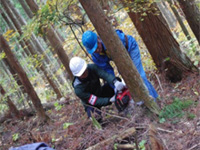
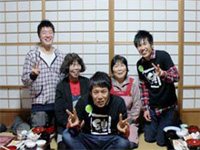
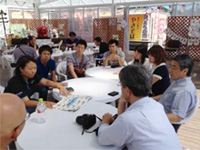
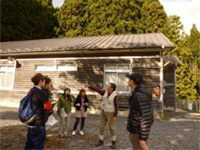
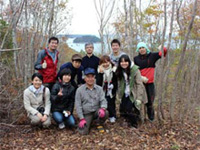
- Minamisanriku Activities Report

- Minamisanriku Tourism

- Chuo University, Chi no Kairou No. 86, "Co-creation of Ecotourism with the Disaster Area"

- 2012, Ministry of Internal Affairs and Communications, "Building Communities through Regional and Academic Collaborations" demonstrative research project

3. Initiatives of Team Jigen and Chuo Support 3.11
and Chuo Support 3.11 at Oshima, Kesennuma, Miyagi Prefecture and Nagomi no Wa
at Oshima, Kesennuma, Miyagi Prefecture and Nagomi no Wa at Soma, Fukushima Prefecture
at Soma, Fukushima Prefecture
(Kayako Sakisaka, Faculty of Policy Studies)
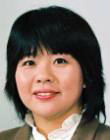
Kayako Sakisaka
Three student-led teams, Team Jigen, Chuo Support 3.11, and Nagomi no Wa, have conducted disaster area support activities since last year. These activities were planned and independently operated by students mainly with the support of the Gakuin-kai, the detailed guidance of the Student Affairs Division, and some external cooperation.
Team Jigen and Chuo Support 3.11mainly focused their efforts on Oshima, Kesennuma, Miyagi Prefecture to support the devastated fishing industry, and the group currently continue exchanges with local communities (photo 1). Team Jigen, was launched by one Faculty of Policy Studies student that was affected by the disaster in Miyagi Prefecture.*1 Team Jigen has worked to get other students involved, and as a result is has sent approximately 150 Chuo University students on 28 occasions to the disaster area. In terms of supporting the fishing industry, it is not as if the students have any particular relevant skills. We are very lucky to be able to share various experiences as we are being accepted and taught by the local community. Educational instruction is also being provided to local junior high school students (click here for details![]() (photo 2)).
(photo 2)).
On Friday night, several students take the night bus from Tokyo to Sanriku. Watching students make travel preparations for seminars in Oshima, Kesennuma and Fukushima Prefecture also fills me with feelings of hope. LDP parliament member Shinjiro Koizumi, who ran into some members of Team Jigen by chance while they were at work on-site, mentioned the diligent activities of Chuo University in his blog after he returned home (click here for details![]() (photo 3)).
(photo 3)).
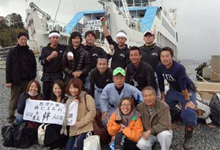
Photo 1
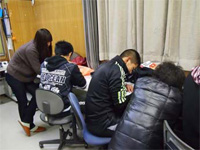
Photo 2
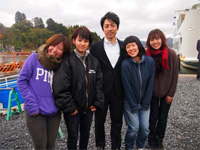
Photo 3
Chuo Support 3.11 was started by a Faculty of Law student from Higashi Matsushima, Miyagi Prefecture.*2 Efforts are also being made to distribute information on activities at the university and in Tokyo. A photo exhibition was held on campus, and a group of fourth-year students has visited the disaster area.
Nagomi no Wa was launched by a Faculty of Law student, and this group focuses its support efforts on Soma-shi, Fukushima Prefecture. The Group has held symposiums, successfully held local product fairs with the university co-op, supported morning markets, conducted interview surveys on temporary housing, and been involved with the operations of a cafe that supports the residents of temporary housing.*3 Group member learn from the local people, and return to the university to rethink and refine their activities as they work to build deeper ties with the community and communicate its message.
Having the students visit disaster areas on multiple occasions helps them to learn about the distances between outsiders and victims and continually observe the daily livelihood of these disaster victims and the changes in their emotions. In face of the challenge of working together with various people from different age groups and backgrounds, it is possible for students to learn the value of walking together at the same pace and with the same perspective as the disaster victims. For some students, making sense of the strong feelings felt as victims immediately after the earthquake has been facilitated through acting as volunteers for a disaster areas other than their hometowns.*1, 2
Two students who were involved in the formation of these university student disaster support groups will depart from Japan this spring to share with the world their experiences and the results of the activities.
- *1: Motoki Yasuhara, "Homeland Ties: Facing Disaster," Chuo University Parents Association, Kusa no Midori, No. 258 (issued August 2012), 6-13

- *2: Satomi Hasegawa, "As a Disaster Victim, as a Volunteer," Chuo University Parents Association, Kusa no Midori, No. 260 (issued November 2012), 17-19

- *3: Hiroaki Nishi, "Our Role in Reconstruction Efforts," Chuo University Parents Association, Kusa no Midori, No. 259 (issued September 2012), 15-17

4. Initiatives in Miyako (Komuro Yuri, Faculty of Law)
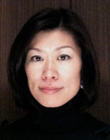
Komuro Yuri
Hamagiku no Tsubomi (Budding Daisies) activities were launched in summer 2012(see HAKUMON Chuo for details on why activities were launched in Miyako)![]() . We cherish relationship gained in our first volunteer activity with the Kuwagasaki afterschool childcare center, and stay involved in an afterschool support volunteer activity along with other activities, such as helped to sell cell-phone straps made by people at a temporary housing, and had network social gatherings with them. Students conducted all planning, communications with activity participants, and arrangements for accommodation, etc.
. We cherish relationship gained in our first volunteer activity with the Kuwagasaki afterschool childcare center, and stay involved in an afterschool support volunteer activity along with other activities, such as helped to sell cell-phone straps made by people at a temporary housing, and had network social gatherings with them. Students conducted all planning, communications with activity participants, and arrangements for accommodation, etc.
I surely feel the strong bonds of "All Chuo" since we made the visit to Miyako and built relationships with Chuo graduates and Chuo related people. They brought care-packages to our students, showed students around in the coastal areas and the city, and explained the city projects toward reconstruction. They support our students behind the scenes. Our students are very fortunate to have the bonds with people in Miyako and to experience their kindness firsthand. One student, who was a high school student at the time of the 3.11 said "It was my first visit to Tohoku after the 3.11. I was aware of the situation in disaster areas from the media; however I realized how devastating it actually was by seeing with my own eyes." "More than anything, I believed that it is most important to stay in touch with people in Miyako and keep communicating with them."
I believe that the comments like these really reflect the positive aspects of Chuo University students.
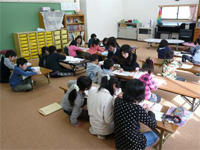
After-school support activities at the Kuwagasaki after-school child care center
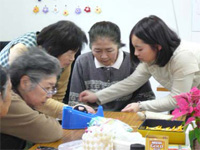
Making wrist bracelets and local snacks at the temporary housing office in Nichiku community park
5. Students supporting sports (Go Murai, School of Law)
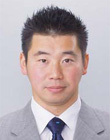
Go Murai
Student members of the Chuo University Table Tennis Club held a sports study session over a three-day period from August 20 to 22, 2012 at Omose Junior High School in Kesennuma, Miyagi Prefecture, during which they provided table tennis lessons to the junior high school students. I would like to provide a brief explanation of the background and an overview of the activities that were conducted.
When I participated as a winter volunteer during March 2012, a request was received for cooperation in sports instruction at Omose Junior High School from Koike, the representative of Nandemo Enjoy Omose Club, a sports-related NGO in the Omose area. In response, we considered what kind of sports-related support could be provided to the students. Although I only served the role of finding the required human resources at university and introducing them, it is my pleasure to introduce the activities that were conducted on this occasion that allowed the Table Tennis Club members that participated in these sports study session to develop close relationships with the local students.
The Omose Junior High School that they visited has had temporary housing constructed in the schoolyard since the earthquake and up until the present day, and it is attended by the students who suffered from the recent disaster. When a request was made for sports support, we had not decided on table tennis at that point, but rather ended up deciding on table tennis in consideration of the state of the schoolyard (sports such as soccer, baseball, or track and field that required schoolyard space would not have been feasible) and consultations with the school on what kind of sport could be supported.
Once a sport was decided on, I held conversations with many students in my classes and other students as well that were involved with table tennis. As a result, in July, the understanding of multiple students members of Chuo University's official Table Tennis Club was readily gained, the club was registered as a university disaster area volunteer group for the summer term, and procedures were conducted in preparation for dispatch to the disaster area.
Afterwards, a schedule was finalized by Omose Junior High School and the Table Tennis Club, and it was decided that 11 Chuo University students would serve as instructors. The participants included university students form Sendai and students that felt they should do something to help the disaster area.
Considering the tears of the junior high school students who received the lessons on the last day, the strong request made by the vice-principle of Omose Junior High School and the NGO intermediary Koike to come next year, and the direct appeal made by the students for the Table Tennis Club to come again when goodbyes were said, it is not hard to imagine the enthusiasm and sincerity of the instruction that was provided over this three-day period.
Furthermore, I would also like to report that hearing the good news that the junior high schools students had managed to advance to the prefecture tournament for both women and men in the rookie tournament that followed the training served to increase the feelings of connection to the disaster area among the members of the Table Tennis Club that participated and that this feeling of connection with the disaster area remains.
6. Conclusion (Hideo Nakazawa)
Other types of activities are being continued by leading students, including community and educational support activities for temporary housing in Kesennuma that have been conducted since the summer following the disaster and efforts aimed at regional reconstruction in Rikuzentakata. Because these initiatives have been introduced in other forms of media (see link below), they have not been covered in this paper.
As is apparent from the nature of each program introduced above, in the Sanriku disaster area a shift is underway from reconstructing physical spaces to restoring human relationships. Chuo University volunteer program is also moving from traditional public service to a form of volunteering that requires participants to fully use their head and bodies and take on both intellectual and physical challenges. Being able to keep up with the pace of these changes and continue success trips to Sanriku is made possible thanks to the local people who are trusting of Chuo University, and we would like to continue expanding activities in the future based on the premise of being given the opportunity to learn and be accepted in the community. The student body has adopted a project focused on improving educational capabilities within the university from 2012 to 2014, meaning that coordinators will be hired in order to create a richer system. Occasionally we get mean spirited questions such as "Why do you keep going to pains to go to such a faraway location? Is it some kind of publicity stunt?" My response is a simple one: "Because all things given, creating new value is fun." Although there are many difficulties in taking on challenges in unprecedented fields, I believe that creating new concepts and added value together with deeply altruistic students will help open the path for Japan's future.
I hope for your continued understanding and support in the future.
- Shirakura Ryunosuke, "Giving Back to Kesennuma," Hakumon Chuo Winter 2012

- "Cannot Forget the Disaster Areas and the Victims," Hakumon Chuo Summer 2012

- "Chuo University Disaster Area Volunteer Fall Program Report," Chuo Online January 26, 2012
- Shirakura Ryunosuke, "Things Seen From the Disaster," Chuo University Parents Association, Kusa no Midori, No. 262 (issued January 2013))

- Masayoshi Tanishita, "Supporting Homeland Restoration Activities in Rikuzentakata," Chuo Online, April 23, 2012
- Hideo Nakazawa
Professor, Faculty of Law, Chuo University
Areas of Specialization: Political Sociology, Regional Sociology - Born in Tokyo. Graduated from the University of Tokyo in 1994. Obtained a PhD in sociology from the University of Tokyo in 2001. Served as an Instructor at the School of Social Information, Sapporo Gakuin University and as Assistant Professor at the School of Literature, Chiba University before assuming his current position in 2009. Affiliated with the Japan Sociological Society and the Japan Association of Regional and Community Studies. His written works include Referendum Movements and Local Regime (Harvest-sha Publishing), which deals with the issue of nuclear power in Niigata Prefecture, and Environmental Sociology (co-written; Yuhikaku Publishing), which covers a broad range of themes including waste products, nuclear power and environmental culture. The former work was awarded the 5th Japan Sociological Society Prize, as well as the 32nd Fujita Prize from the Tokyo Institute for Municipal Research.
- Masayoshi Tanishita
Professor, Faculty of Science and Engineering, Chuo University
Areas of specialization: Urban Engineering, Quantitative Spatial Analysis - Professor Tanishita was born in Ishikawa Prefecture in 1967.
He withdrew from the Doctoral Course, School of Engineering, the University of Tokyo, in 1992.
He became a Professor in 2008, on the Faculty of Science and Engineering, Chuo University, after assuming the positions of Associate Researcher at the University of Tokyo, Full-Time Lecturer in School of Engineering, at the University of Tokyo, Full-Time Lecturer, Assistant Professor and Associate Professor on the Faculty of Science and Engineering, Chuo University.
Area of specialization: Urban Engineering, Quantitative Spatial Analysis Current areas of research: the external costs of automobiles and related tax systems, effects of regional planning and building agreement on the real estate market, physiological evaluation of walking space, management organization of public space, and the like. - Kayako Sakisaka
Specially-Appointed Associate Professor, Faculty of Policy Studies, Chuo University
Areas of Specialization: Global Health, Social Epidemiology, Public Health - Born in Tokyo. Graduated from the School of International Health, the Graduate School of Medicine, the University of Tokyo with Master of Public Health (MPH) and Doctor of Health Science degrees (PhD); and Takemi Program, Harvard School of Public Health (2009 - 2010). Also graduated from the Graduate School of International Politics, Economics and Communication, Aoyama Gakuin University with a Master of International Economics degree. Specializes in Global health, social epidemiology, statistics, and public health. Served as an Assistant Professor on the Faculty of Medicine and the Graduate School of Medicine, the University of Tokyo from 2004 to 2010 before assuming her current position in April 2011.
- Yuri Komuro
Associate Professor of Applied Linguistics, English Lexicography, Faculty of Law, Chuo University - Graduated from the Department of Literature, Japan Women's University in 1993. Obtained a PhD in lexicography from the University of Exeter (England) in 2009. In 2005, assumed the position of Full-Time Instructor at the Faculty of Law, Chuo University. Has held her current position since 2007. Affiliated with the European Society of Lexicography and the Asian Association for Lexicography. Involved in the writing of the Lighthouse English-Japanese Dictionary and the Luminous English-Japanese Dictionary.
- Go Murai
Associate Professor, Faculty of Law, Chuo University
Area of Specialization: Physical education - Graduated from the Faculty of Law at the Chuo University.
Completed requirements for Doctorate in Health and Sport Sciences, Chukyo University.
After serving as an assistant at the Research Institute of Health and Sport Sciences, Chukyo University, he has served at his current position since 2008.
Area of Specialization: Physical education
Member of Japan Society of Physical Education, Health and Sport Sciences and Japanese Society of Sports Psychology
- Research Activities as a Member of Research Fellowship for Young Scientists (DC1), Japan Society for the Promotion of Science (JSPS) Shuma Tsurumi
- Important Factors for Innovation in Payment Services Nobuhiko Sugiura
- Beyond the Concepts of Fellow Citizens and Foreigners— To Achieve SDGs Goal 10 “Reduce Inequality Within and Among Countries” Rika Lee
- Diary of Struggles in Cambodia Fumie Fukuoka
- How Can We Measure Learning Ability?
—Analysis of a Competency Self-Assessment Questionnaire— Yu Saito / Yoko Neha - The Making of the Movie Kirakira Megane








